Irish whiskey investment returns have emerged as a truly captivating prospect for investors seeking both financial gain and an enriching ownership experience. Over recent years, this centuries-old spirit has defied expectations by rapidly climbing the ranks within luxury assets, outperforming many rivals in both appreciation and resilience. But what is fueling this phenomenon, and why are more investors—from seasoned collectors in Europe to adventurous newcomers worldwide—turning to Irish whiskey as a serious component of their alternative investment strategy?
Whether you are exploring how to diversify your portfolio amidst global market uncertainty, searching for tangible ways to safeguard wealth against inflation, or simply drawn to the romance and cultural heritage of Irish whiskey, this guide is crafted precisely for you.
The allure lies not just in the numbers—though the performance has been notable—but in the story that every bottle and cask tells. Connoisseurs and high-net-worth individuals alike are discovering the unique joys of owning rare releases or entire casks: the sense of history, craftsmanship, and community that traditional equities can rarely replicate. With Irish whiskey’s global sales booming (doubling in the last decade) and its status as the fastest-growing premium spirit category, the confluence of scarcity, cultural cachet, and marketplace sophistication offers an unprecedented opportunity.
In this expanded guide, you’ll not only unlock actionable investment strategies, but also gain an insider’s perspective on the forces driving sustained price growth, and the nuanced risks involved. Whether you are just curious about rare bottles or considering cross-continental cask investments, this comprehensive resource will empower you with the knowledge, actionable steps, and confidence needed to assess if Irish whiskey could become the most rewarding—and enjoyable—investment in your portfolio.
Why Irish Whiskey is a Compelling Investment Opportunity
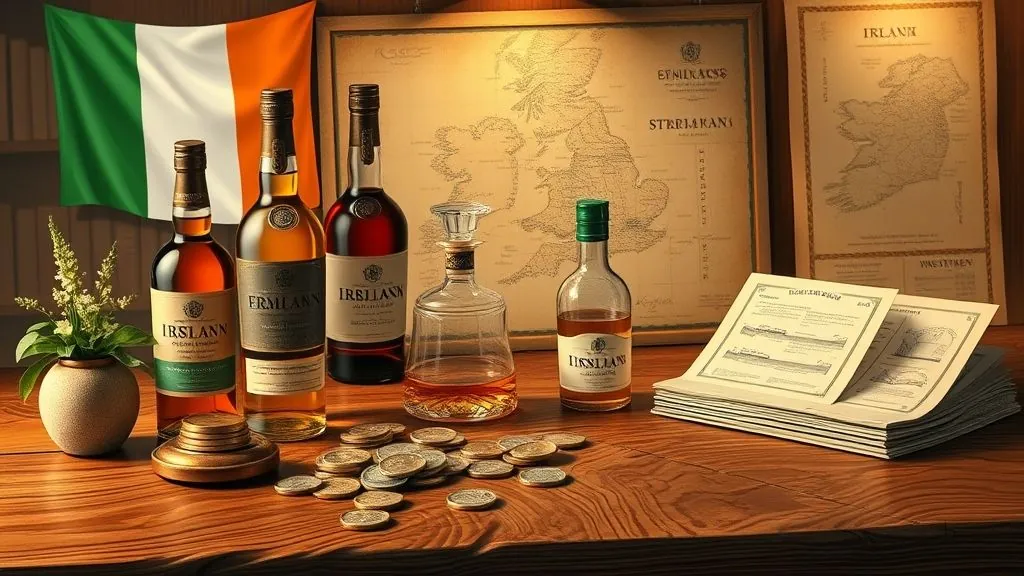
Irish whiskey is enjoying a true renaissance. From its near collapse in the late 20th century, it has rebounded to become the world’s fastest-growing premium spirits segment. Here’s why investors are paying attention:
1. Explosive Global Demand
The last decade has seen Irish whiskey sales double globally, outstripping even the meteoric rise of Scotch single malt and bourbon. In 2024 alone, exports topped 14 million 9-litre cases, led by surging interest in North America, Europe, and Asia.
Premium brands like Jameson, Redbreast, and The Spot Range have become household names, while new craft distilleries are entering the market at an unprecedented pace. This surging consumer demand creates a robust foundation for price appreciation and strong Irish whiskey investment returns.
2. Scarcity and Limited Production
Unlike most financial assets, whiskey is inherently limited by time and nature. Laws require a minimum three-year aging period, but truly coveted bottles and casks spend a decade or more developing their unique characteristics.
Once an exceptional whisky vintage is bottled—or a cask is sold and bottled for a special edition—it’s gone forever. As bottles are consumed or stored away by collectors, the available supply of rare Irish whiskey dwindles, causing prices to rise. This dynamic of increasing scarcity underpins strong whiskey investment returns.
3. Tangible Ownership and Emotional Reward
Irish whiskey offers something stocks, bonds, and even cryptocurrencies cannot: something you can actually hold, admire, and even enjoy sharing. Cask and bottle investments touch on heritage, artistry, and personal enjoyment in a way few assets can match.
Not only are you potentially enjoying financial gains, but you’re also building a personal legacy—perhaps even bottling your own exclusive whiskey, which can be gifted, shared, or passed down through generations. For many, returns on whiskey investment are as much about pride of ownership as monetary reward.
4. Portfolio Diversification and Inflation Hedging
Irish whiskey acts as a portfolio diversifier, often uncorrelated with equity and real estate markets. When traditional asset classes wobble, the best collectibles—including rare whiskey—have historically shown resilience. Moreover, as a real asset with genuine scarcity, whiskey can offer a hedge against inflation and currency fluctuation.
Deep Dive: Historical Irish Whiskey Investment Returns
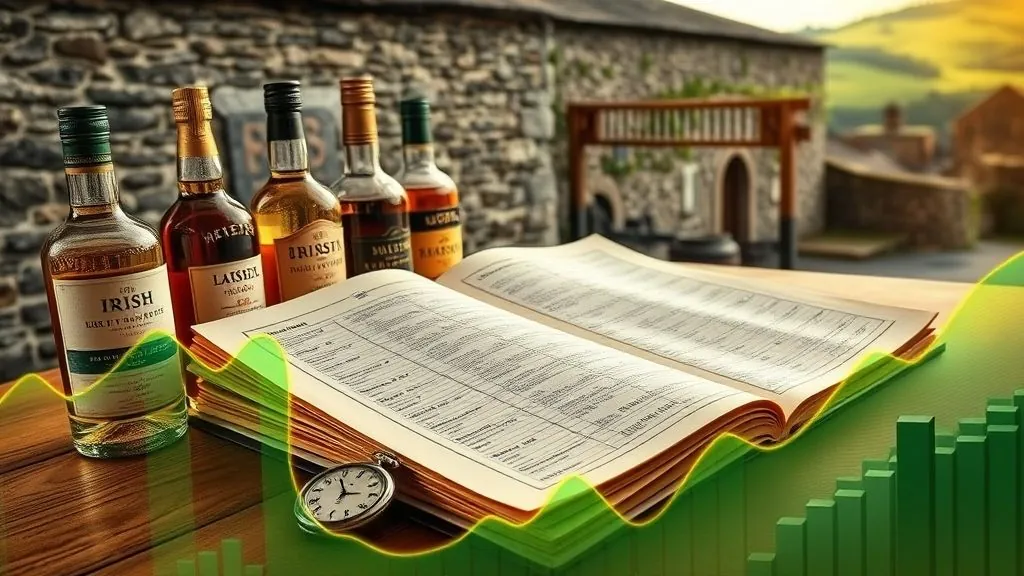
Understanding Irish whiskey investment returns starts with a close look at historical performance—both at the market level and in standout cases.
Irish Whiskey’s Track Record vs. Other Luxury Assets
Data from Knight Frank and Rare Whisky 101 indicate that high-end Irish whiskey bottles and casks have outperformed many other collectibles over the past decade:
- Rare whiskey bottles (Irish/Scotch combined): Between 2013 and 2023, rare bottle values soared by more than 320%. Irish brands like Midleton Very Rare have often led, especially at auctions.
- Cask investments: Irish whiskey casks have returned anywhere from 10% to 13% per annum, rivaling or exceeding top wine, art, and classic car indices.
- Broader luxury assets like fine art and wine typically return 5–8% per annum, while global equities have averaged 6–10% (with greater volatility).
Case Study: The Emerald Isle Collection
In 2021, The Craft Irish Whiskey Co. shocked the world when its Emerald Isle Collection fetched a stunning $2.8 million at auction. This ultra-rare set included a 30-year-old single malt paired with Fabergé jewelry. While not every investment reaches such heights, this demonstrates the stratospheric upside at the rarest end.
Everyday Investing: Midleton Very Rare
For more accessible investments, look at Midleton Very Rare releases. Bottles from the 1980s (original retail £30–50) now routinely fetch £3,000–5,000+ at international auctions—a CAGR well above 10%. Even “modern” annual releases can double or triple in value within five years if properly stored and presented.
Cask vs. Bottle Investments: Which Performs Better?
- Cask investments: Provide the greatest upside for patient investors. As whiskey matures, the liquid grows in scarcity and potential quality. Once it hits “peak” age (12, 18, or 21 years), demand from bottlers and brands tends to spike.
- Bottle investments: Typically more liquid (pun intended!), easier to access, and require less up-front capital. Returns of 5–10% per annum are common for limited-edition or well-chosen vintage bottles.
Recent Market Developments
- New distilleries: The past decade has seen a boom, with dozens of independent distilleries opening across Ireland. Some skeptics worry this could saturate the market, but experts note that demand and brand differentiation are still expanding faster than supply.
- Auction growth: Online whiskey auctions have exploded, making it easier for investors around the world to buy and sell both bottles and casks. This increased liquidity is good news for returns.
Expected Returns: What Can Real Investors Achieve?

When evaluating Irish whiskey investment returns, realism matters. Here’s what you can likely expect based on current and historical trends:
Typical Irish Whiskey Investment Returns
| Investment Type | Typical Annual Return Range | Risk Profile | Notes |
|---|---|---|---|
| Casks (long-term) | 10% – 13% | Moderate | Requires patience (5–15 years) |
| Rare bottles | 5% – 10% | Low to Moderate | More accessible, some “moonshot” upside |
| Unicorn/Ultra-rare | 20%+ (exceptional cases) | High | Limited supply, big auction potential |
| Index funds/asset pools | 6% – 9% | Moderate/Liquid | Spreads risk across assets |
What Drives These Returns?
- Scarcity (supply vs. demand): The older and rarer the whiskey, the higher its appreciation.
- Brand cachet: Prestige distilleries and single cask releases command top premiums.
- Maturation effect: Whiskey literally improves and becomes more desirable with age—few assets can claim this.
- Presentation & condition: Original packaging, labels, and intact tax stamps are vital for maximizing value.
- Market infrastructure: The growth of auctions and brokers increases liquidity, making it easier to exit profitably.
How to Invest in Irish Whiskey: A Step-by-Step Guide
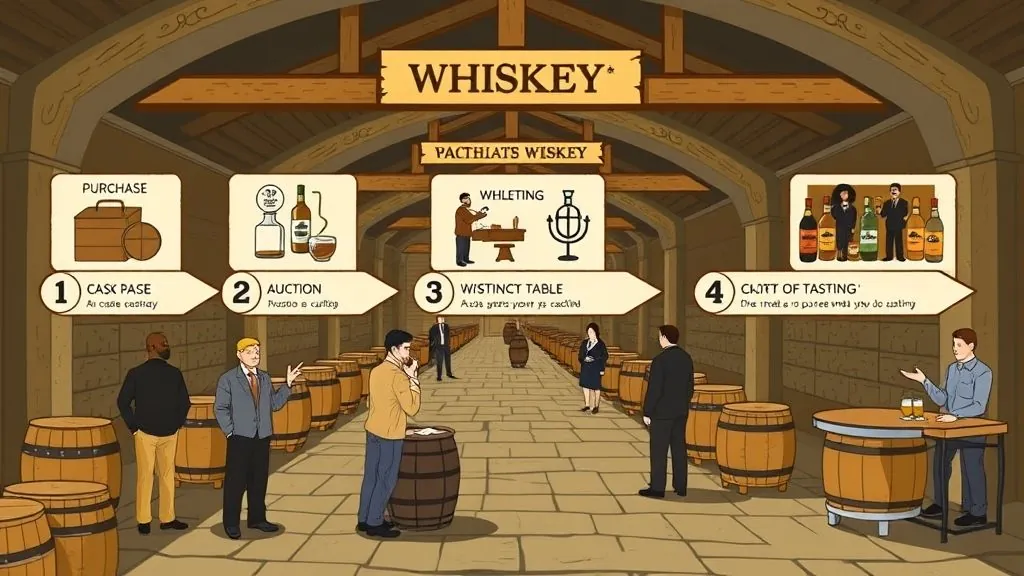
There are two main routes: cask investments and collectible bottle purchases. Let’s explore both in depth.
Investing in Irish Whiskey Casks
Buying a cask of maturing whiskey is the most authentic and potentially rewarding approach.
How it Works
- Purchase agreement: Investors buy a new-make or maturing cask from a distillery or specialist investment firm. Prices typically begin at €3,500–€10,000 for Irish whiskey, depending on age and distillery reputation.
- Storage: Casks must be stored in a government-bonded warehouse, ensuring both legal compliance and safe maturation. Annual fees (including insurance) range from €50–€200 per cask.
- Aging: Minimum legal age is 3 years, but optimal value is typically reached after 8–20 years. The spirit develops complexity, color, and rarity over time.
- Exit strategies:
- Sell the cask to a bottler or the distillery (often at a premium).
- Auction the cask (new, but increasingly common).
- Bottle the spirit—either for personal enjoyment, as corporate gifts, or even for retail if local laws permit.
Practical Example
Imagine Jane invests in a 200-liter first-fill bourbon cask at €4,000. After 12 years, its market value has grown by 11% per year, making it worth approximately €12,400 (not accounting for storage costs). She chooses to bottle her cask, selling 280 bottles for €65 each, netting over €18,000.
Cask-Provenance Checklist
- Always verify paperwork: Legitimate cask ownership documents, insurance, and independent valuation.
- Choose reputable storage: Avoid private arrangements—bonded, regularly-audited warehouses are the safest bet.
- Understand tax rules: In Ireland and the UK, whiskey casks often qualify as “wasting assets,” granting significant tax relief on capital gains, provided they are not bottled for consumption within seven years.
Risks and How to Mitigate Them
- Evaporation (the ‘angel’s share’): Casks naturally lose volume each year—plan for 2–3% reduction annually.
- Quality control: If the whiskey “turns” during aging, its resale value may disappoint. Regular independent sampling is wise.
Investing in Collectible Irish Whiskey Bottles
Single bottles offer a lower financial barrier to entry and are easier to buy, store, and resell.
Key Strategies
- Focus on rare, limited releases: Annual releases from top brands (Midleton, Redbreast, Bushmills), single cask bottlings, and discontinued expressions.
- Chase provenance: Bottles with impeccable packaging, seals, and storage history command the highest prices.
- Stay informed: Auction results and new releases move quickly; monitor platforms like WhiskyAuctioneer, Bonhams, and Sotheby’s.
- Buy in original presentation: Keep packaging, certificates, and labels pristine—originality makes a huge difference at resale.
Practical Example
- In 2015, Redbreast 21 Year Old retailed for approximately €180. High grading, well-stored bottles are now worth €600–€900 apiece—around a 15% annualized return for early investors.
- Midleton Very Rare releases routinely double or triple in secondary value within five years.
Storing Bottles for Maximum Value
- Upright position: Preserve cork integrity and avoid leaks.
- Dark, cool environment: Direct light and temperature swings can ruin whiskey.
- Loose, careful handling: Minimize bottle movement to prevent label wear or breakage.
Actionable Advice: How to Maximize Irish Whiskey Investment Returns
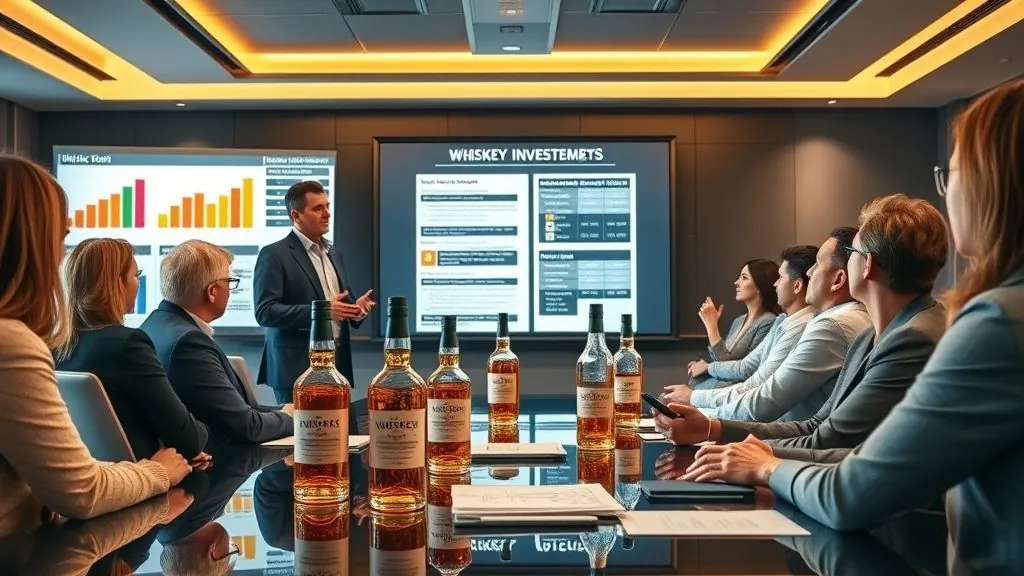
While the fundamentals are strong, success comes down to smart strategy and diligent execution. Here’s how to boost your Irish whiskey investment returns:
1. Research Brands and Markets Relentlessly
- Subscribe to newsletters: WhiskeyInvestDirect, WhiskyCast, and top auction sites provide regular market analysis.
- Monitor auctions: Track realized prices for both bottles and casks. Learn which brands and expressions outperform.
- Learn provenance: Old Irish whiskey houses have storied histories—knowing which releases are undervalued today can pay off handsomely.
2. Diversify Your Holdings
Never put all your eggs in one basket. Spread your investment across:
- Different distilleries
- Both casks and bottles
- Various ages, maturation styles (e.g., bourbon vs. sherry cask)
- Mix of luxury and emerging brands
This spreads risk and increases your chances of capturing significant price appreciation.
3. Work Only With Licensed, Reputable Brokers
- Ask for credentials: Reputable firms are transparent about storage, ownership structure, fees, and exit strategies.
- Third-party audits: Request periodic verification of your cask or bottle location and condition.
- Avoid cold-callers/web-only operators: Major scams have involved unregulated firms preying on inexperienced investors.
4. Adopt a Patient, Long-Term Mindset
- Timing matters: Markets ebb and flow, but long holding periods (8–15 years for casks, at least 5 for bottles) usually deliver the best results.
- Don’t panic-sell: Wait for key anniversaries or when brands experience surges in global popularity for your best chance to maximize returns.
5. Plan Your Exit Before You Invest
- Cask resale agreements: Many initial purchase agreements include guaranteed buyback or resale terms.
- Bottle auctions: Familiarize yourself with selling processes at trusted international whiskey auction houses.
- Private sales: Join whiskey enthusiast networks (clubs, forums) for peer-to-peer dealmaking—often with higher realized prices.
Advanced Topics: Tax, Insurance, and Global Market Opportunities
Understanding Tax Implications
- Ireland and UK “wasting asset” exemption: Whiskey casks are often considered wasting assets (lifespan < 50 years), often exempting them from capital gains tax if held in a bonded warehouse and not bottled within seven years.
- Bottle sales: May be subject to capital gains in certain countries. Professional advice is essential—especially if selling large collections.
- International considerations: For U.S., Asian, and Middle Eastern investors, consult local tax experts before diving in.
Insurance and Security
- Bonded storage: Always insist on insurance against loss, theft, or fire as part of your storage fees.
- Inventory audits: Annual third-party audits are standard at major warehouses and for asset-backed whiskey investment funds.
Geographic and Brand Diversification
With global demand on the rise, consider:
- Mainstay Irish brands: Redbreast, Midleton, The Spot range, Bushmills, Teeling
- Emerging distilleries: Dingle, Waterford, Powerscourt, and more.
- Target international demand: Asian (especially Chinese), U.S., and European connoisseurs drive much of the premium market’s growth.
Real-World Success Stories: Profiting from Irish Whiskey Investments
Let’s look at a few recent cases where investors have realized meaningful Irish whiskey investment returns.
The Dublin Distillery Revival
In 2013, investors purchased casks from a newly established Dublin distillery at about €3,000 per cask. By 2023, following high demand for young Irish single malts and an acclaimed “Whiskey Advocate” award, comparable casks sold for €11,000–€15,000. Early investors enjoyed over 13% per annum in compound growth, excluding sale commissions.
Collectors’ Clubs Turn Profitable
A private whiskey tasting club in London pooled resources in 2012 to buy one bottle each of 14 annual Midleton Very Rare releases. By 2024, the club sold half its bottles at auction for over £60,000—triple its initial outlay. The profits were used to fund even rarer acquisitions and luxury tasting events for club members.
The Corporate Gifting Trend
Companies in Asia and Europe are increasingly purchasing private-label casks as executive gifts, creating new sources of demand (and profits) for those who bought casks a decade ago, before this trend took off.
Risks and How to Navigate Them
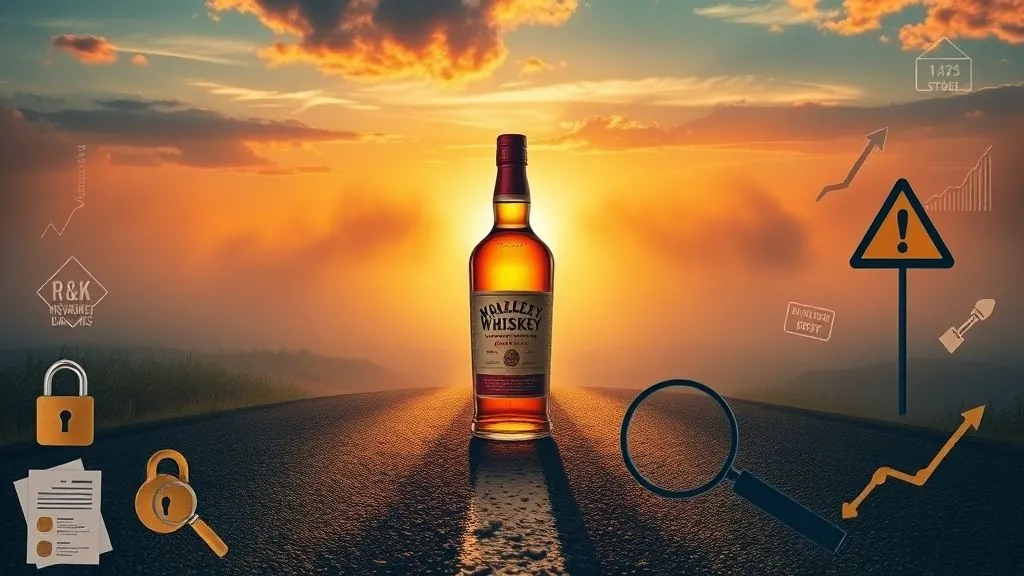
No investment is without downside. While Irish whiskey investment returns are attractive, risks include:
Market Volatility
- Trends can change: A sudden glut of new distilleries, mismanagement at a major brand, or global economic downturns can pressure prices.
- Mitigation: Stick to top brands, avoid trendy but unproven releases, diversify widely.
Illiquidity
- Bottles and casks take time to sell: Unlike stocks or ETFs, you may wait weeks or months to realize a sale at your desired price.
- Mitigation: Plan exits in advance, and consider smaller bottle investments for quicker liquidity.
Authenticity and Counterfeits
- Fake bottles are a scourge: Only buy from established auction houses, distilleries, or verified brokers.
- Cask scams: Never buy “off the books”—don’t trust private sellers lacking documentation or offering seemingly unbeatable deals.
Storage and Condition Risk
- Bottles: Sunlight, heat, or handling can damage labels, seals, or the whiskey itself, slashing value.
- Casks: Leakage, contamination, or improper maturation can render a cask nearly worthless.
- Mitigation: Always use professional storage, keep full insurance, and conduct regular checks or tastings.
Frequently Asked Questions (FAQs): Everything You Need to Know
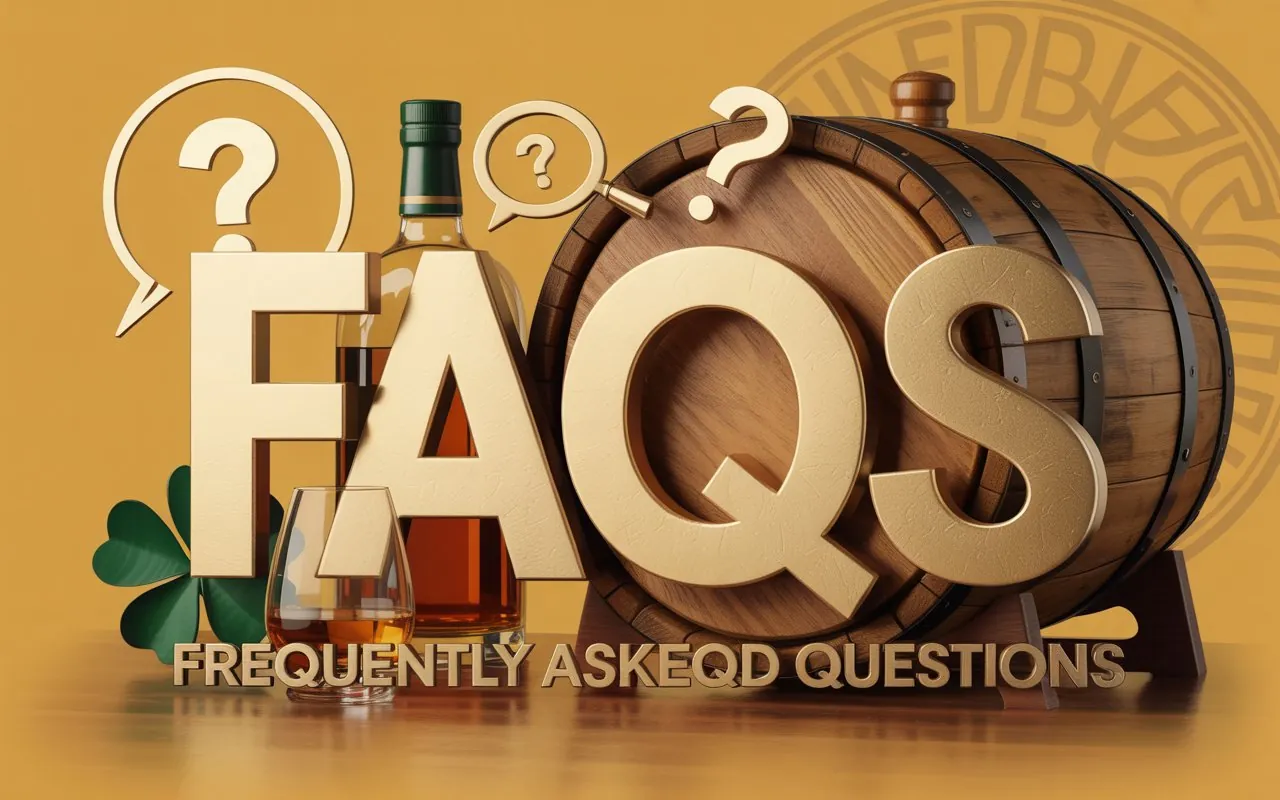
1. How much capital do I need to start investing in Irish whiskey?
- Cask investments: Entry-level casks start at around €3,500–€5,000. Older casks or those from top brands can run up to €15,000–€30,000.
- Bottle investments: Exceptional, limited-edition bottles start at €100–€500, with blue-chip bottles fetching thousands at auction.
2. What are realistic Irish whiskey investment returns for a beginner?
- For casks: 10–13% per annum (over minimum five years) is achievable if you choose wisely and store correctly.
- For bottles: 5–10% is realistic for annual appreciation, with standout years occasionally yielding much more.
3. Irish whiskey investment regulated?
- Most cask/bottle investments are NOT regulated by national finance authorities—buyer beware.
- Stick to established channels: Official distilleries, audited brokers, and global auction houses.
4. an I physically visit my cask or bottles?
- Yes, usually: Many bonded warehouses and distilleries offer “tasting days” for investors to sample their casks or inspect bottle storage.
5. How do I sell my whiskey investment?
- Casks: Sell back to the distillery, to independent bottlers, auction your cask (new services), or bottle for retail/personal consumption.
- Bottles: List with major online auction platforms, sell to collectors, or consign to a retail broker.
6. What taxes apply to Irish whiskey investment returns?
- Casks: Often exempt from capital gains under “wasting asset” rules in Ireland and the UK.
- Bottles: May be subject to local capital gains or VAT on profits in some jurisdictions. Always get professional advice for your country.
7. hould You Pursue Irish Whiskey Investment Returns?
Irish whiskey investment returns, especially in the last decade, have consistently beaten expectations. For those seeking memorable, authentic, and high-potential opportunities, this asset class offers:
- Tangible wealth and legacy
- Long-term inflation protection
- Globally growing demand and diminishing supply
- Emotional and social rewards alongside financial gain
conclusion
While risks do exist—primarily in illiquidity, market shifts, and authenticity—these can be managed with diligent research, diversification, and professional partnerships. Above all, success in Irish whiskey investment comes to those who combine patience with passion. If you’re ready to take a first step, start small, buy from reputable sources, and enjoy the journey. The combined satisfaction of watching your investment grow and potentially sampling your own exclusive whiskey is something no stock or property can match. Remember: the best investors in this space balance profit-seeking with a genuine appreciation for the craft, culture, and community of Irish whiskey. Whether you aim to build a collection, secure multi-generational wealth, or simply enjoy a remarkable bottle or two, the world of Irish whiskey investment is open—and richer than ever before.